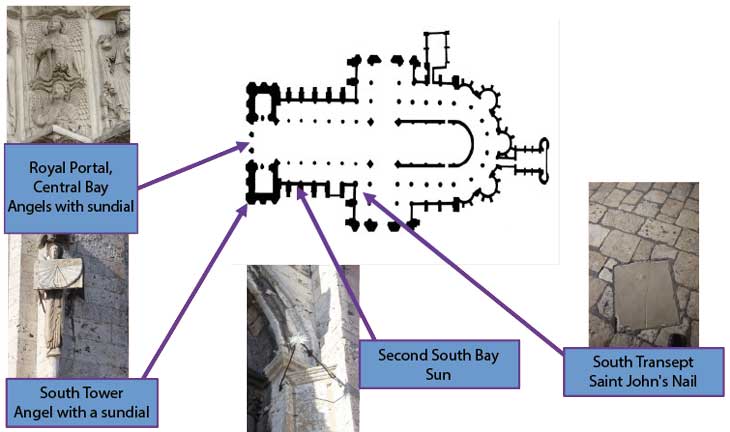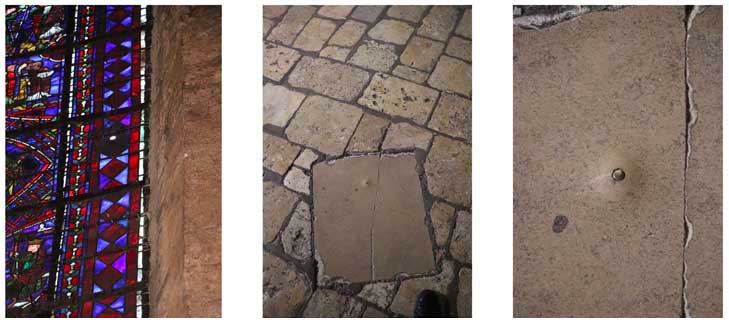Sundials, astrolab clocks, and much more, the whole of time is represented in Chartres Cathedral, from the north porch to the south porch, from the Creation of the World to the Last Judgment, from Alpha to Omega…
How is time measured in the cathedral, how is the day divided up…?
Extract from a lecture given by the Cathedral’s Visits & Welcome Service as part of its Spring 2023 Cycle.
The sun’s movement through the day
As we all know, the sun rises in the east and sets in the west, passing through the south.
This course of the sun across the sky enables the shadow cast by the sun to measure the time, thanks to a stick called a gnomon, when planted upright, and a sundial.
The sundial
In order to read the time all year round, the gnomon must be tilted according to the latitude of the reading location (in Chartres, 48.4439° latitude): in this position, the gnomon is called a style. All instruments that read the time using the shadow cast by the sun or a ray of sunlight can be called :
- Gnomon,
- Meridian, since they generally face south at midday,
- Sundial.
Position of sundials in the cathedral
In our cathedral, we can see a meridian, two sundials, and sculptures of sundials:
– in the south transept: the nail of St. John;
– outside, in the second south bay of the nave, above the “donkey that flies”: a sundial, in the shape of a “sun”;
– outside, at the corner of the south bell tower: a sundial, the famous angel with a dial;
- outside, at the royal portal, in the arch around the “Christ in Majesty”, angels carry sundials.

Le clou de Saint-Jean
This meridian was installed in 1701 by Canon Claude Estienne, a physicist and astronomer, certainly to regulate clocks.
In the Saint Apollinaire stained-glass window, some of the glass panes on the right-hand edge of the window have been removed and replaced by a metal rhombus pierced with glass. On the floor, a stone slab is pierced by a hole into which a brass nail has been inserted.
Two other nails were used for the winter solstice: they were probably located under the current step of the altar at the transept crossing. On the summer solstice, a ray of sunlight at noon is positioned on the nail.
But today’s sun is no longer in the nail: the stained-glass window – like all those in the cathedral – was removed in 1939 as a protective measure. The glassworker who replaced the window in 1952 found the piece of metal and thought it was a mistake. He discarded it and replaced it with a glass rhombus with a hole in it. The nail is 22 mm in diameter, and the beam of light before 1939 was also 22 mm. Today, the beam of light is 117 mm long…

Why the name Clou de Saint-Jean? Today, the phenomenon is most frequently observed on June 21.
In the past, the people of Chartres watched the event on June 24, the feast day of St. John; this is also the day of the St. John bonfires. In the 4th century, the Church fixed Christmas on the winter solstice, when the sun renews and the days grow longer, and St. John’s Day on the summer solstice, when the days grow shorter.
This solar symbol is inspired by St. John’s own words: speaking of Jesus, he said, “He must increase and I must decrease”.
In 1780, four scholars from Chartres suggested to the clergy that the meridian at Saint-Jean should be completed with a black paving that would follow the course of the sun. The canons agreed, but changed their minds for fear of distracting the faithful.
There are other meridian windows in churches, such as the spectacular one at Saint Sulpice in Paris.
To be continued…
Extract from a talk given by Christine Afota and Georges Athanassiadis, guides at the Cathedral’s Visitor Service, as part of the Cycles thématiques (Printemps 2023).